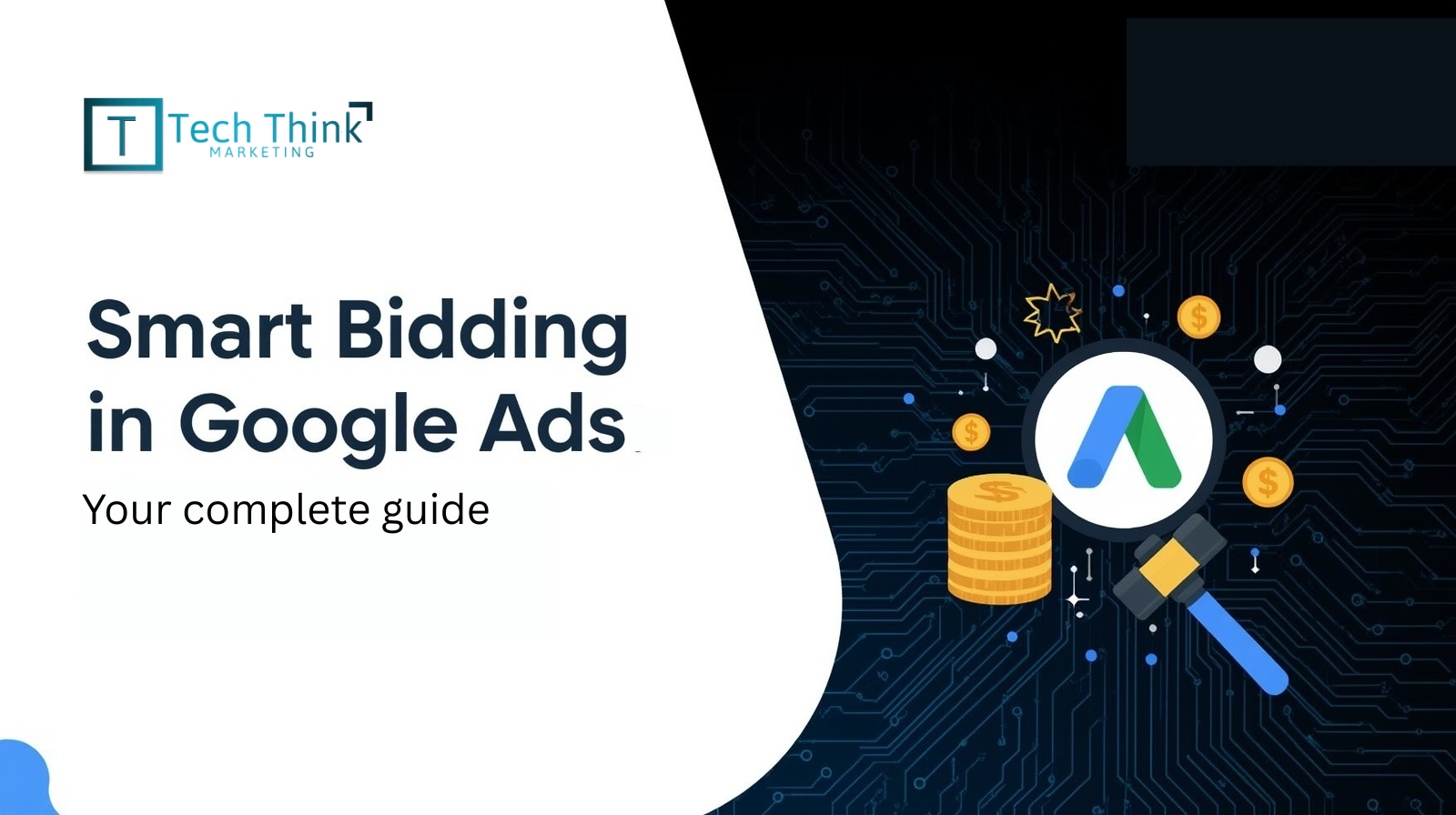Office No. 608, Lunkad Sky Station, Viman Nagar Road, Pune, Maharashtra 411014, India
Phone: +1 213-261-0597
contact@techthinkmarketing.com
Introduction
Smart Bidding Strategies in Google Ads In the world of digital marketing, one phrase continues to dominate: “Content is King.” While algorithms evolve and platforms rise and fall, content remains the backbone of every successful online strategy. But what does it take to build a content marketing strategy that actually wins in 2025?
Let’s break down how content fuels digital growth and the exact steps to create a strategy that attracts, engages, and converts your target audience.
Table of Contents
ToggleWhat Is Smart Bidding in Google Ads
Smart Bidding refers Smart Bidding Strategies in Google Ads to a set of automated bidding strategies in Google Ads that use machine learning to optimize your bids in real-time.
Instead of manually adjusting bids, smart bidding leverages data signals like:
- User location
- Device
- Time of day
- Browsing behavior
- Conversion history
Google’s algorithm evaluates these signals to predict the likelihood of a conversion and automatically adjusts your bid accordingly.
Benefits of Smart Bidding
Key Smart Bidding Strategies Explained
Google Ads offers several types of smart bidding strategies tailored to specific campaign goals. Let’s break them down:
1. Objective CPA (Per Procurement Cost)
Objective: Get the most conversion per action per action.
Best for: Lead Generation, Service-Based Business.
Here’s how it works: Google automatically adjusts dialects to achieve conversion to goal CPA.
2. Target Roas (return to ad expenditures)
Dimensions: Maximize the conversion value while maintaining the desired ROAs.
Best for: e-commerce and product-based business.
Here’s how it works: Google uses previous data to predict future revenues with each click and bid accordingly.
3. Do maximum conversion
Objective: Get maximum budget conversion.
Best for: Campaign without strict CPA goals.
Here’s how it works: Google automatically sets dialects to achieve the most conversion.
4. Do maximum conversion value
Objective: Get the highest total conversion value.
Best for: Business focusing on revenue instead of bare conversions.
Here’s how it works: Prioritize high -value conversions based on your goals and previous performance.
5. Increased CPC (cost click)
Objective: Adjust manual dialects to increase conversion.
Best for: Who still wants some manual control.
Here’s how it works: Google is increasing automatically or reduces dialects to improve the conversion options.
How to Choose the Right Bidding Strategy
Picking the right smart bidding strategy depends on your campaign goals, data availability, and budget.
| Goal | Recommended Strategy |
|---|---|
| Lead generation | Target CPA or Maximize Conversions |
| E-commerce sales | Target ROAS or Maximize Conversion Value |
| Traffic & clicks | Enhanced CPC or Manual CPC |
| Broad brand awareness | Use bidding with automated targeting (e.g., Maximize Clicks + Smart Display) |
Smart Bidding Best Practices for 2025
1. Set clear conversion tracking
Smart bid conversion depends much more on data. Make sure:
Conversion tracking you have installed correctly
You track the correct actions (form submission, purchase, registration)
2. Give it time
Smart bidals use machine learning, which is improved with data. Allow at least 2 weeks or 30 conversions to adapt algorithms.
3. Use a comprehensive battle with smart bid
In 2025, Google encourages to use a broad match keyword with the Smart Bid-Denne combination box unlocks full AI-controlled access capacity.
4. Set realistic goals
Do not enter unrealistic CPA or ROAS goals. If your goal is very strict, you cannot set your advertising auction at all.
5. Monitor and adjust (but not too often)
Check the weekly performance, not daily. Ask for repeatedly and reset the stages of learning and can harm the performance.
6. Segment campaign goals
Do not mix different goals in a campaign. For example, do not use the same strategy for both product sales and newspapers registrations.
Common mistakes to escape
Even with automation, many advertisers make a mistake:
- Proper conversion is not tracked
- Change the strategies very quickly
- Set unrealistic CPA or ROAS -OBJECTIVE
- Don’t provide enough data/time to learn
- Management of more than a fully automated system
Avoid these mistakes to allow smart bids to function
Final Thoughts
In 2025, Google Ads smart bidding is no longer optional—it’s essential for scaling efficiently and optimizing results. These strategies help businesses of all sizes run campaigns that are data-driven, cost-efficient, and conversion-focused.
The key is to understand your goals, set up accurate conversion tracking, and allow machine learning to work over time.
Whether you’re just starting or scaling up, embracing smart bidding is the smartest move for modern advertisers.
effectively.





